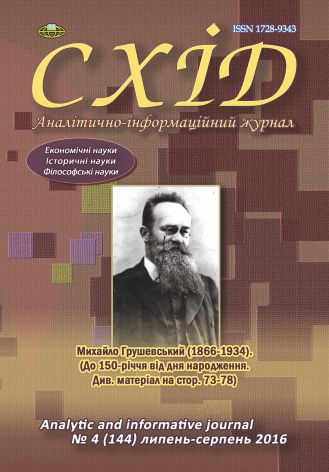Ukrainian Greek-Catholic Church (UGCC): Tourism and Environmental Activity in the Carpathians (30-ies of the XX century)
DOI:
https://doi.org/10.21847/1728-9343.2016.4(144).77987Keywords:
Ukrainian Greek-Catholic Church (UGCC), еnvironmental activity, tourism, estate, ecological and spiritual culture, nationAbstract
In this article we have analyzed some aspects of economic management of UGCC during 30-ies of XX century in the Carpathians, in particular, in the estate of Perehinsko: tourism and protection of nature. It has been proved that UGCC used to connect closely tourism activity with environmental protection as such combination of two areas of economic activity of the Church in complex social and political conditions of Halychyna of that time promoted formation of ecological and spiritual culture of the nation, consolidated the public opinion of the possibility of preservation of national identity of Halychyna people in future.
The picturesque landscapes of Gorgany, spring medicinal water and pure mountain air conduced fast development of tourism in this corner of the Carpathian Mountains. The church was very fruitful in combining tourism and nature protection. First of all, in 30-ies of XX century the Central Administration of Church Property has created a number of nature reserves in the surroundings of urban settlement of Osmoloda. The first nature reserve was cedar reserve organized in 1934 with aim of Pinuscembra L. protection. During the following years (from 1935 to 1938) here were created a number of other reserves (fir, pine, beech, pool "Nyvka", "Pidliute" and others), that were joined into one reserve complex - Ukrainian National Nature Park.
Near the urban settlement of Osmoloda, in Pidliute area, was constructed in the beginning of the century a unique Cedar Chamber by local craftsmen without any single nail. It has served a summer residence of the Church in Gorgany where used to come the priests and numerous guests of the archdiocese for rest and treatment.
At the same place used to function a number of natural Carpathian springs. Local spring waters has a wide range of treatment and health power, therefore, tourists and vacationers in Pidliute used it for drinking and bathing. It was a well-known Carpathian resort where used to come for treatment not only wealthy Halician people, but also ordinary people. In the documents of that time it has been named "people's hospital" and medical doctor, professor Panchyshyn was chief medical officer there for many years.
Many archive documents prove that in the process of creation of these and other forest reserves, the environment experts of Perehinsko estate have done a lot for comfort of tourists, vacationers and visitors, including advertisement leaflets, warnings, rules, instructions, orders and so on, concerning behavior of people on the territory of the reserve.
The church has always maintained a close relation with different tourism and cultural-educational public organizations (Plast, Sokil, Plai, Shevchenko Scientific Society, Ridna Shkola, Vacation House, and others). Here they had their camps, frequent trainings, conferences, work meetings, and so on.References
Central State Historical Archive of Ukraine, Lviv, fund 409, description 1, case 1392, 200 ark. (ukr).
Central State Historical Archive of Ukraine, Lviv, fond 409, description 1, case 1414, 237 ark. (ukr).
Departmental archive of Osmoloda State Forestry, fund 1, description 1, case 627, 255 ark. (ukr).
Anisimov, E. (1977), Class essence of ideology and practice of Uniate church, report of thesis for the scientific degree of Candidate of Philosophy Sciences: 09.00.02, Moscow, 20 pages (rus).
Bandrivskyi, M.S. (2001), Monument protection activity of church in the context of national-cultural movement in Halychyna (end of XIX-XX centuries), abstract of thesis for the degree of Candidate of Historical Sciences in specialty 07.00.01 “History of Ukraine”, Lviv, 18 p. (ukr).
Danylenko, S. (1970), Path of shame and treason, Kyiv, 360 p. (ukr).
Dobrych, V. (1968). In the shade of Saint George (on recreation activity of Greek-Catholic church), Lviv, 163 p. (ukr).
Yegreshii, O.I. (2003), Social-political and cultural-educational activity of bishop Hryhorii Khomyshyn (1904-1945), Abstract of thesis for the degree of Candidate of Historical Sciences in specialty 07.00.01 “History of Ukraine”, Ivano-Frankivsk, 21 p. (ukr).
Zaborovskyi, Ya. (1995), Metropolitan Andrei Sheptytskyi. Outline of life and service to church and people. (1865-1944), Ivano-Frankivsk, 64 p. (ukr).
Lutskyi, Ya. (2003), Ukrainian ethnographic tourism movement in Halychyna (1830-1939), Ivano-Frankivsk, 121 p. (ukr).
Marchuk, V.V. (2001), Ukrainian Greek-Catholic Church: historical essay, Ivano-Frankivsk, 164 p. (ukr).
Perevezii, V.O. (1998), Education activity of Greek-Catholic church in 20-30-ies of XX century, abstract of thesis for the degree of Candidate of Historical Sciences in specialty 07.00.01 “History of Ukraine”, Kyiv, 18 p. (ukr).
Haydukevych O.O. (2007), Nature protection activities of the UGCC in Galicia in the 20-30’s XX century, Abstract of thesis for the degree of candidate of historical sciences in specialty 07.00.01 “History of Ukraine”, Ivano-Frankivsk, 20 p. (ukr).
Haydukevych O.O. (2016), Metropolitan Andrei Sheptytskyi - environmental activist of Halychyna, Skhid, № 1 (141), January-February, Mariupol, 35-39 (ukr). doi: 10.21847/1728-9343.2016.1(141).64290.
Downloads
Published
How to Cite
Issue
Section
License
Copyright (c) 2016 Olena Haydukevych

This work is licensed under a Creative Commons Attribution-NonCommercial-NoDerivatives 4.0 International License.
1. Authors bear responsibility for the accuracy of facts, quotations, numbers and names used.
2. Manuscripts are not sent back.
3. The publisher does not always agree with the authors' opinion.
4. The authors reserve the right to authorship of the work and pass the first publication right of this work to the journal under the terms of a Creative Commons Attribution Non-Commercial License, which allows others to freely distribute the published research with the obligatory reference to the authors of the original work and the first publication of the work in this journal.
5. The authors have the right to conclude separate supplement agreements that relate to non-exclusive work distribution in the form in which it has been published by the journal (for example, to upload the work to the online storage of the journal or publish it as part of a monograph), provided that the reference to the first publication of the work in this journal is included.

